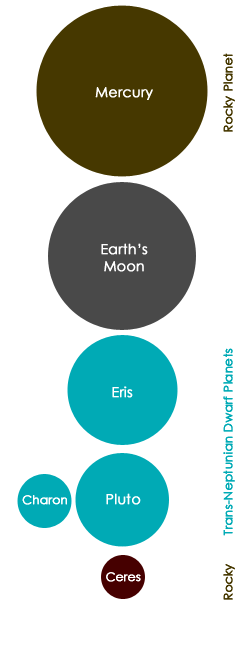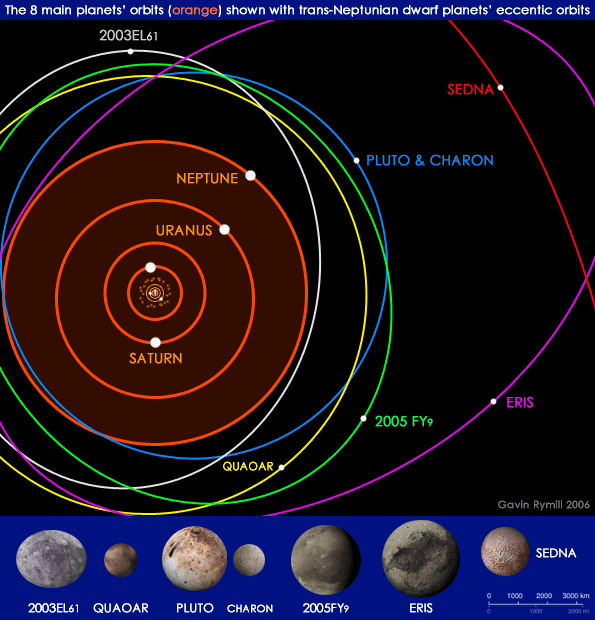| |
 In
August 2006, the International Astronomical Union (IAU) met
to try to decide, once and for all, what Pluto was, and whether
it deserved to be a planet. In doing so it became important
to decide what constituted a planet. In
August 2006, the International Astronomical Union (IAU) met
to try to decide, once and for all, what Pluto was, and whether
it deserved to be a planet. In doing so it became important
to decide what constituted a planet.
What's the Problem with Pluto?
Pluto was discovered in 1930 although its existance was predicted
mathematically due to gravitational forces which were being
exerted at the edge of the solar system. However Pluto's discovery
did not necessarily account for the predictions and its status
has often been in doubt for various reasons. Then recent discovery
of Eris in 2003 (formerly classified as '2003
UB313') caused a problem because this new 'planet' was of similar
composition to Pluto but was larger than our
existing 'ninth planet'. So if Pluto was a planet, surely Eris
would be too. The discoveries of more bodies, such as 2005FY9
increased the problem. Why weren't these new bodies planets?
All the accepted eight planets are divided into either rocky
worlds or gas giants. Pluto, being ice and rock, does not quite
fit either group and is in some ways more like a comet. Pluto
also lacked a normal-shaped circular orbit around the sun, having
instead one which was very eliptical, more like Eris. Pluto
was smaller than Mercury, Earth's moon and a variety of other
satellites. Beyond the simple fact that people had got used
to calling Pluto a planet, there was very little to support
it's case for planetary status.
The Media Jumping the Gun
The week before a decision was made there was great media interest
around the IAU meeting and prior to the final outcome, a propsal
was publicised in which virtually any object with a spherical
shape could have been upgraded to planetary status. A provisional
number of 12 planets, increasing to 50 or more was on the horizon!
This generated interest in the possible promotion back to planetary
status of Ceres, the largest asteroid, which was happily thought
of as a planet from its discovery in 1801 until it was reappraised
150 years later. A category of planet called 'Plutons' was also
proposed which would have included any trans-Neptunian object
of any decent size, including the afforementioned Eris. Ultimately
these proposals were all rejected but their high-profile media
coverage and the inaccurate television information (such as
Channel 5 and Channel 4 News which even managed to mis-pronounce
'Charon') led to confusion.
Pluto is not a Planet
On August 24th 2006, the real definition of a planet emerged
for the first time ever. It bore close resemblance to the initial
proposal, but with one addition:
A planet is something around a star
that can form itself into a solid sphere under the influence
of its own gravity and it has cleared the neighbourhood
around its orbit.
What this means is that any object which is merely the largest
amongst a cloud of other objects will not count, such as Ceres,
the largest asteroid of the astoid belt.
A second definition was made, which is that any
object which is nearly round due to its own gravity but has
not cleared its orbit (and is not a satellite of another
object) is a Dwarf Planet.
Pluto has been placed in this second category of Dwarf Planet
and is no longer one of "The Planets". As such there
are only eight planets in our solar system. Eris also belongs
in this category.
The diagram below is the best illustration of why Pluto does
not belong in the family of planets. When its orbit is plotted
alongside its fellow trans-Neptunian objects, it blends into
this crop of icy oddballs quite happily and bears little relation
to its more weighty and uniform cousins.
|
|

 In
August 2006, the International Astronomical Union (IAU) met
to try to decide, once and for all, what Pluto was, and whether
it deserved to be a planet. In doing so it became important
to decide what constituted a planet.
In
August 2006, the International Astronomical Union (IAU) met
to try to decide, once and for all, what Pluto was, and whether
it deserved to be a planet. In doing so it became important
to decide what constituted a planet.